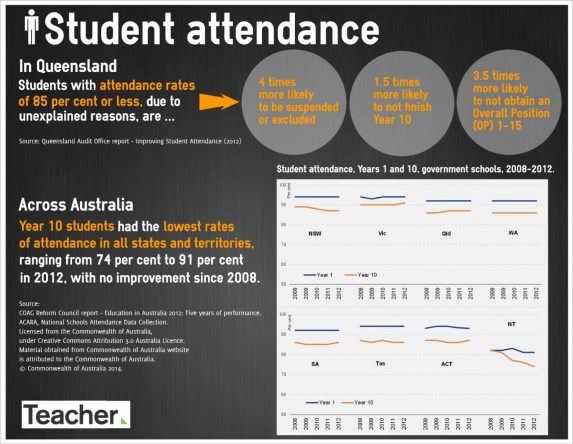Determined not to ‘run up the white flag' on attendance when he joined his new school, principal Mike O'Connor devised a framework that he hoped would not only raise awareness of the issue in the community, but tackle it head on.
Teacher was there at the start of the journey, sharing the story of Brisbane's Browns Plains State High School in Attendance: It's a big deal, and a delighted O'Connor got in touch recently with a progress update.
New data show the percentage of students with 95 per cent plus attendance increased from 16.9 per cent in 2011 to 43.6 per cent in 2014, and it's tracking at 46.1 per cent so far in 2015. Meanwhile, the percentage of students with an attendance of 85 per cent and below fell from 38.7 per cent in 2011 to 18.1 per cent in 2014 (and to 17.5 per cent so far this year).
‘We're really proud of that; the staff are really proud of that because they're the ones that have actually done it. I've just built the framework and made a lot of noise - the staff have actually made the phone calls, followed up with the kids ...,' O'Connor says. ‘All of those strategies that we discussed [for the previous Teacher article] are starting to pay off.'
Those strategies include getting every student at the school to track their own attendance every five weeks, putting in place a system of rewards and positive reinforcement, and individually case managing students with poor attendance - working with families and support agencies.
There has also been a renewed focus on consistent teaching practice (Browns Plains SHS uses Dimensions of Learning as its pedagogical framework) and creating a disciplined, safe environment.

New data show an increase in attendance rates at Browns Plains State High School.
O'Connor says the target is to raise whole school attendance to 95 per cent plus. ‘Last year it was 91.2 per cent, this year we're hitting closer to 92 per cent, but we want to keep pushing and pushing. Before we really focused on this I think there was a lot of just running up the white flag.'
To hit the target, the principal and his staff will need to find a solution to the problem of the Friday dip – whole school attendance on that day of the week is around 4 per cent lower than average. 'We haven't yet put our finger on it. We think it's probably just a local, cultural “have a Friday off”.'
Strategies being considered include running tuck shop specials and extracurricular activities on Fridays. O'Connor reveals Lyn Sharrat and Michael Fullan's work (Putting Faces on the Data) has also been influential.
‘… When we actually look at our numbers and see that on Fridays [there is] 87 per cent whole school attendance, it sounds bad. But, when we say there are, on average, 137 students away every Friday and on a Wednesday there are 70 students away, it's a significant difference. People actually see the numbers and go “Wow, that's a big difference”.'
Another challenge has been convincing all parents of the importance of their child attending every day, but it's one the school leader relishes. ‘I'm just not prepared to give up on it because I think 90 per cent [whole school attendance] is unacceptable - on average every kid missing a day a fortnight is just outrageous.'
He has now started his doctorate part-time through Griffith University, looking at the issue of student attendance. His studies will explore, among other topics, successful and unsuccessful strategies, and the impact of attendance on student learning outcomes. ‘My goal is, and I'm not ashamed to say it, to become the authority on this in Australia.'
Do your students know their own attendance rate? Do you know your class or whole school attendance rate?
When managing attendance at your school, is there a framework, or set of strategies in place?
Have these strategies made an impact on the attendance rates at the school?



